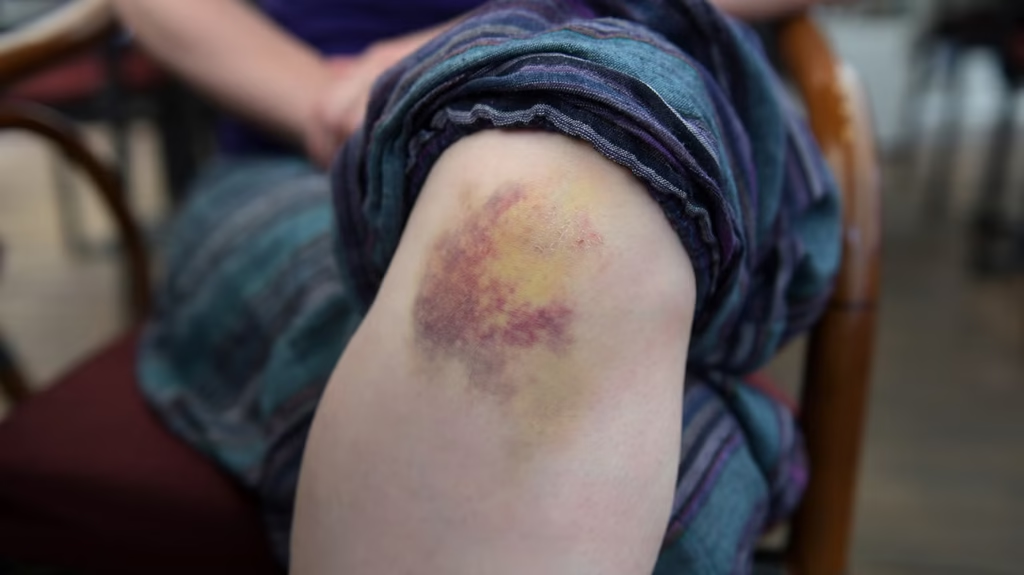Introduction
If you’ve noticed unexplained bruises after starting blood thinners, you’re not alone. Blood thinners and increased bruising risk are closely linked, affecting millions managing heart disease, atrial fibrillation, or clotting disorders. This guide unpacks the science, separates myths from facts, and empowers you with actionable strategies—without compromising your treatment.
Why Blood Thinners Trigger Bruising
Blood thinners (anticoagulants like warfarin or DOACs, antiplatelets like aspirin) slow clot formation. This prevents strokes but disrupts the body’s repair system for damaged capillaries. Even minor bumps can leak blood under the skin, causing:
-
Larger, darker bruises
-
Delayed healing (up to 3× longer in seniors)
-
Bruises in unusual places (chest, back, face)
✅ Also check: Morpheus8 Safety and Side Effects

Blood Thinner Types: Bruising Risk Compared
| Type | Examples | Bruising Severity |
|---|---|---|
| DOACs | Apixaban, Rivaroxaban | Moderate |
| Antiplatelets | Aspirin, Clopidogrel | Mild-Moderate |
| Warfarin | Jantoven | High (requires monitoring) |
| Heparin | Injectables | Variable |
⚠️ Key Insight: DOACs cause 30% fewer major bleeds than warfarin (Michigan Medicine).
7 Factors Amplifying Bruising Risk
-
Age: Thinner skin + reduced fat cushion = easier capillary breaks.
-
Combined Medications: NSAIDs (ibuprofen), steroids, or SSRAs multiply risk.
-
Supplements: Ginkgo biloba, fish oil, or vitamin E act as blood thinners.
-
Alcohol: >1 drink/day increases bleeding.
-
Platelet Disorders: Low counts (thrombocytopenia) worsen bruising.
-
Skin Fragility: Conditions like Ehlers-Danlos syndrome.
-
Dosage Errors: Skipping INR tests on warfarin.
✅ Also check: Avoiding Alcohol and Fatty Foods During Treatment
When Bruises Signal Danger: Red Flags
Seek emergency care if you experience:
-
Bruises larger than a tennis ball
-
Bruising without injury (especially on torso/face)
-
Accompanying symptoms:
-
Nosebleeds lasting >10 mins
-
Blood in urine/stool
-
Sudden swelling/pain (compartment syndrome)
-
📊 Stat: 40% of bruise-related hospitalizations involve blood thinner users (British Heart Foundation).
5-Step Bruise Management Protocol
-
ICE: Apply wrapped ice for 15 mins/hour.
-
ELEVATE: Keep bruised area above heart level.
-
PROTECT: Avoid pressure/impact (e.g., compression sleeves).
-
PAIN RELIEF: Use acetaminophen—never NSAIDs.
-
TIME: Most bruises fade in 2–4 weeks.
✅ Also check: Temporary Redness and Bruising Post-Treatment

Debunking 4 Blood Thinner Myths
Myth 1: “Bruising means my dose is wrong.”
→ Truth: Occasional bruises are normal. Report patterns to your doctor.
Myth 2: “I can stop taking meds if I bruise.”
→ Truth: Abrupt stoppage raises stroke risk 5-fold (Hartford Hospital).
Myth 3: “Natural supplements are safer.”
→ Truth: Garlic/ginkgo interact dangerously with DOACs.
Myth 4: “All bruises are harmless.”
→ Truth: Unexplained facial bruising may indicate domestic abuse.
Case Study: Balancing Safety & Efficacy
Maria, 68, on apixaban for AFib:
-
Issue: Frequent arm/leg bruises after gardening.
-
Solution:
-
Switched from aspirin to clopidogrel (lower bleeding risk).
-
Added protective gardening sleeves.
-
Scheduled monthly INR checks.
-
-
Outcome: 70% fewer bruises in 3 months.
FAQs: Blood Thinners & Bruising
Q: Can I reduce bruising without quitting meds?
A: Yes! Avoid contact sports, use soft-bristle toothbrushes, and moisturize skin daily.
Q: Do topical creams help?
A: Arnica gel may reduce visibility, but won’t prevent bruising.
Q: Why do bruises change color?
A: Hemoglobin breakdown turns them red→purple→green→yellow.
Q: Are children on blood thinners at higher risk?
A: Yes—supervise play and use padded clothing.
✅ Also check: Areas to Avoid During Cavitation
When to Talk to Your Doctor
Contact your provider if you notice:
-
Bruises lasting >4 weeks
-
Bruises expanding in size
-
Signs of infection (red streaks, pus)
-
Unusual fatigue (anemia from internal bleeding)
✅ Also check: How Long Side Effects Last
The Lifesaving Trade-Off
While blood thinners and increased bruising risk are concerning, remember:
“For AFib patients, blood thinners reduce stroke risk by 64%—outweighing bruising concerns.” — Mayo Clinic
Work with your doctor to:
-
Adjust doses (e.g., lower DOAC strength)
-
Explore alternatives (e.g., left atrial appendage closure)
-
Never compromise clot protection for cosmetic reasons.
CTA: Prioritize Your Vascular Health
Bruising might be a side effect, but stopping blood thinners unsupervised can be deadly. Equip yourself with tools for safer management:
👉 Explore medical-grade safety devices like fall sensors or pulse oximeters at Dune Medical Devices. Protect your health without fear.
✅ Also check: Best Medical Alert Systems
✅ Also check: Portable Bladder Scanner
Outbound Links Used:
